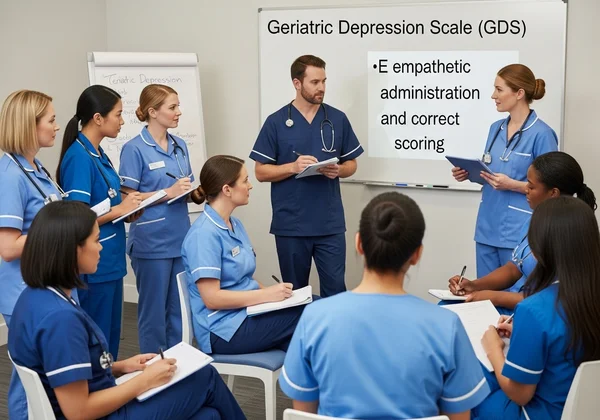Geriatric Depression Scale in Clinical Practice: An Essential Guide for Professionals
Addressing the mental health of older adults is a critical component of comprehensive healthcare, yet it often remains an under-recognized challenge. For medical professionals and care institutions, having reliable and efficient screening tools is paramount for early detection and intervention. This guide provides a structured approach to integrating the Geriatric Depression Scale (GDS) into daily practice for improved patient outcomes. This article explores how you can seamlessly incorporate a scientifically validated tool, enhancing the quality of geriatric care through practical administration, interpretation, and implementation. For those ready to streamline this process, our online GDS test offers a secure and user-friendly platform.
Why Integrate the Geriatric Depression Scale in Clinical Use?
The Geriatric Depression Scale, first developed by Yesavage et al, is a globally recognized screening tool specifically designed for older adults. Unlike general depression inventories, its simple "yes/no" format avoids complex questions about somatic symptoms that can overlap with common age-related physical ailments, reducing the rate of false positives. Integrating the GDS into clinical practice provides a structured, evidence-based method for identifying depressive symptoms that might otherwise be dismissed as normal signs of aging.
This standardized approach allows for consistent monitoring of a patient's emotional well-being over time. By establishing a baseline score, clinicians can track the effectiveness of interventions, adjust care plans, and communicate more effectively with patients, families, and other healthcare providers. The use of a validated instrument like the GDS elevates the standard of care and demonstrates a commitment to holistic patient health. Utilizing a platform that offers free GDS screening can remove barriers to widespread implementation.
The Imperative of Early Detection in Geriatric Depression
Untreated depression in older adults is linked to a range of negative outcomes, including increased morbidity, cognitive decline, diminished functional ability, and a higher risk of mortality, as highlighted by the National Institute on Aging. Early detection is therefore not just beneficial; it is essential. The GDS serves as a vital first step in identifying at-risk individuals who may require a more thorough diagnostic evaluation. By flagging potential issues before they become severe, healthcare professionals can initiate timely conversations, referrals, and treatments. This proactive approach can significantly improve a patient's quality of life, reduce healthcare costs associated with complications, and foster better overall health management.

Enhancing Patient Care Through Standardized Assessment
Consistency is key in effective healthcare. A standardized assessment tool like the GDS ensures that every older adult is screened using the same reliable criteria, regardless of the clinician or care setting. This uniformity minimizes subjective bias and provides objective data to support clinical judgment. It allows for clear documentation of mental health status, which is crucial for interdisciplinary team communication, especially in complex care environments like hospitals or long-term care facilities. Furthermore, a standardized score makes it easier to measure patient progress and the efficacy of therapeutic strategies, leading to more personalized and effective patient care.
Administering the GDS for Professionals: Best Practices
Effective administration of the Geriatric Depression Scale is crucial for obtaining accurate results. While the tool is straightforward, following best practices ensures that the patient feels comfortable and provides honest responses. The primary goal is to create a private, non-judgmental environment where the individual feels safe to reflect on their feelings over the past week. It is also important to ensure the patient has any necessary aids, such as glasses or hearing devices, to fully understand the questions.
For professionals seeking efficiency without compromising accuracy, our online tool simplifies the administration process. It presents questions clearly, records answers securely, and calculates the score instantly, freeing up valuable clinical time. Whether administered directly by a clinician or completed by the patient on a tablet, the digital format ensures consistency and reduces the chance of manual scoring errors.

Choosing the Right GDS Version: 15-item vs. 30-item
The GDS is available in two primary versions, and choosing the right one depends on the clinical context. The full 30-item scale is the original, comprehensive version that provides a detailed screening. The GDS Short Form, or 15-item version, is an abbreviated tool that is often preferred for its speed and ease of use, making it ideal for routine screenings in busy primary care settings or for patients who may have difficulty with longer assessments.
- GDS-30 (Long Form): Recommended for initial comprehensive assessments or when a more in-depth screening is warranted.
- GDS-15 (Short Form): Excellent for rapid, routine screenings, follow-up assessments, and use with frail individuals or those with cognitive limitations. Take the GDS-15 now to see how quick and effective it can be.
Step-by-Step Guide to Effective GDS Administration
Proper GDS administration is key to the validity of the results. Here is a simple guide for clinicians:
- Prepare the Environment: Choose a quiet, private space free from interruptions.
- Introduce the Tool: Explain the purpose of the questionnaire in simple terms. Emphasize that it is a screening for mood, not a test with right or wrong answers, and that the results are confidential.
- Provide Clear Instructions: Instruct the patient to answer based on how they have felt over the past week.
- Administer the Questions: Read each question aloud, clearly and slowly. If the patient is completing it themselves, ensure the text is large enough and they understand the "yes/no" format.
- Avoid Interpretation: Do not rephrase questions or influence the patient's answers. If they are unsure, encourage them to give the best response they can.
- Score and Discuss: Tally the score according to the established guidelines and prepare to discuss the results in a supportive and empathetic manner.
Implementing GDS in Nursing Homes & Care Settings
Routine nursing home depression screening is a cornerstone of high-quality residential care. The transient nature of mood in older adults, often influenced by health changes, social isolation, or loss, makes regular assessment critical. Implementing the GDS as a standard protocol in nursing homes and other long-term care settings helps identify residents who need mental health support, enabling staff to implement appropriate care plans and interventions promptly.
Integrating the GDS into the facility’s workflow ensures that mental health is treated with the same importance as physical health. This process can be greatly simplified by using a centralized digital platform. Explore our platform to see how you can manage screenings efficiently across multiple residents, track changes over time, and maintain secure, confidential records.
Training Staff for GDS Proficiency and Consistency
For successful implementation, training staff at all levels—from nurses to care aides—is essential. Proper training ensures everyone understands the purpose of the GDS, how to administer it correctly and empathetically, and the importance of reporting scores to the clinical team. Consistency in administration is vital for reliable data. Training should cover creating a supportive environment, reading questions without bias, and understanding the basic scoring mechanism. Well-trained staff are more confident and competent, leading to better resident engagement and more accurate screening results.

Integrating GDS into Routine Geriatric Mental Health Assessment Protocols
To be most effective, the GDS should be integrated into existing routine assessment protocols. This means incorporating it into admission assessments, quarterly or annual reviews, and any time a significant change in a resident's health or behavior is observed. By making the GDS a standard part of the overall geriatric mental health assessment, facilities can create a proactive culture of mental wellness. This systematic approach ensures no resident is overlooked and provides valuable longitudinal data to guide care decisions, aligning with best practices like those outlined in the American Geriatrics Society clinical guidelines. Digital tools can help streamline your assessments, making this integration seamless.
Interpreting GDS Scores and Guiding Next Steps
Once the GDS is administered, the next critical step is interpreting the score and determining the appropriate follow-up. It is vital to remember and communicate to patients and their families that the GDS is a screening tool, not a diagnostic one. A high score indicates the likelihood of depression and warrants a comprehensive evaluation by a qualified healthcare professional, such as a psychiatrist, psychologist, or primary care physician with expertise in geriatric mental health. The score is a conversation starter, not a conclusion.
Our platform not only provides instant scoring but also offers optional, AI-powered insights. These reports can help translate a numerical score into actionable insights, identifying potential strengths and challenges that can facilitate a more productive conversation with the patient and inform the development of a preliminary care plan.
Understanding GDS Score Ranges and Severity Indicators
The GDS score ranges provide a clear framework for interpreting the results. While slight variations exist, the generally accepted scoring is as follows:
For the GDS-15 (Short Form):
- 0–4: Normal range
- 5–8: Suggests mild depression
- 9–11: Suggests moderate depression
- 12–15: Suggests severe depression
For the GDS-30 (Long Form):
- 0–9: Normal range
- 10–19: Suggests mild depression
- 20–30: Suggests severe depression
A score of 5 or greater on the GDS-15 (or 10 on the GDS-30) is typically used as the cutoff to recommend further evaluation. Get instant scores with our online version to quickly identify these indicators.
Communicating Results and Developing Care Plans
Effectively communicating GDS results is an art that requires empathy and clarity. Present the score as an indicator of emotional well-being, not a label. Use it as a basis for a collaborative discussion about the patient’s feelings and experiences. Based on the score and subsequent clinical evaluation, you can develop person-centered care plans. These may include referrals to mental health specialists, recommendations for psychotherapy, medication management, or other evidence-based treatment options for depression.

Empowering Better Geriatric Mental Health Care with the GDS
The Geriatric Depression Scale is an invaluable tool for any professional dedicated to the well-being of older adults. Its integration into clinical practice facilitates early detection, promotes standardized care, and provides objective data to guide treatment. By leveraging modern tools to streamline its administration and interpretation, clinicians can enhance their efficiency and focus on what matters most: providing compassionate and effective care. We encourage you to try the free GDS test to experience its simplicity and power firsthand.
By making the GDS a routine part of your practice, you empower both your patients and your clinical team. You create a system that prioritizes mental health, fostering an environment where older adults can thrive emotionally and physically. We invite you to visit our homepage to learn more and begin your journey toward enhanced geriatric care today.
Common Questions for GDS Professionals
Is the Geriatric Depression Scale a diagnostic tool?
No, it is crucial to understand that the GDS is a screening tool, not a diagnostic instrument. A high score indicates that a person may have depression and should undergo a comprehensive diagnostic evaluation by a qualified healthcare professional. It helps identify individuals who require further assessment but does not replace a clinical diagnosis.
How do you score the Geriatric Depression Scale effectively?
Scoring involves counting the number of "yes" or "no" answers that align with depressive symptoms. For most questions, a "yes" indicates a symptom, but for a few, a "no" is the indicator. To ensure 100% accuracy and save time, using an automated online version is the most effective method. Our platform provides an easy GDS assessment with instant and reliable scoring.
What is the GDS short form (15-item) compared to the long form (30-item)?
The GDS short form (GDS-15) is a validated, abbreviated version of the original GDS-30. It includes the 15 questions that were found to have the highest correlation with depressive symptoms. The GDS-15 is ideal for quick, routine screenings in busy clinical settings, while the GDS-30 is better suited for initial, more comprehensive assessments. Both are reliable screening tools for identifying depressive symptoms in older adults.